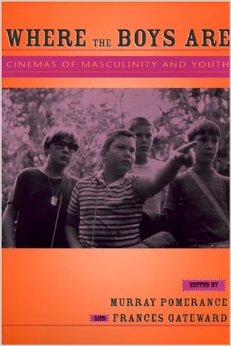“Where The Boys Are: Cinemas Of Masculinity And Youth (Contemporary Approaches to Film and Television”
 Good books that focus on the coming of age genre in cinema are rare to find . I have been looking for a while and am finally able to present to you the result from those searches.
Good books that focus on the coming of age genre in cinema are rare to find . I have been looking for a while and am finally able to present to you the result from those searches.
From what I have read so far – I developed quite an understanding on the issues discussed in the book. It is written in higher style – more suitable for researches than a casual readers – but everyone will be able to get enormous amount of information from it.
The book is providing a good baseline for good discussions which I intent to introduce to this blog alongside the movie reviews you are used to seeing here . I would give you a small example from the introductory pages :
“In film, boyhood has long held a central place. Since the earliest days of cinema—what Tom Gunning has called the “cinema of attractions”—people have been watching the capers of the mischievous boy onscreen. This kind of teasing, half-mocking irresponsibility in the name of pure delight—that quite early became a hallmark of the cinematic boy—made, according to Charles Musser, “a formative contribution to the popular bad-boy genre of early film comedy”
I am sure that you can easily recall at least dozen bad – boy comedies – such as Home Alone , Dennis the Menace, Ciske the Rat- even Son of Rambow ….etc. I think that a discussion for those types of movies would turn quite interesting.
Of course boyhood is not age limited – ( or is it – another future topics for discussion ) and I guess the next quote from the book would prove that to you :
“Even from the beginning of narrative film, then, boys have been seen onscreen as unruly tikes, agents of aggression, symbols of the collapse of the civilized forces of nature as contradistinguished from refined products of socialization and control. Inherent screen boyishness has been a disregard for limitation, a spontaneous expression of freedom, a mocking wit, in general a stylishly choreographed antisocial impulse. And the end product of screen boyhood, the screened man, is either a grown-up continuity of what he always was—blithe rogue, tongue-in-cheek and lovable criminal, awkward adventurer, all of these adamantly presexual and Panic— or a cop-out, a prisoner of the culture he had once fought in the mud puddles but could at some crucial point of transference and surrender resist no longer.”
I hope that this short book introduction will rise some interest in you and you will be looking forwards for the next posts and and topics inspired by the book. Please let me know if you will be interested in discussions inspired by the book Where The Boys Are: Cinemas Of Masculinity And Youth (Contemporary Approaches to Film and Television” via the comment form below this post.